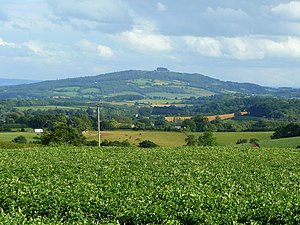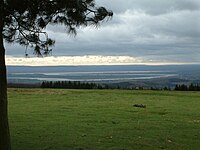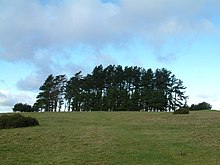May Hill: Difference between revisions
Created page with "{{Infobox hill |name=May Hill |county=Gloucestershire |picture=Fine view of May Hill - geograph.org.uk - 906969.jpg |picture caption=May Hill from Perrystone Hill |os grid ref..." |
|||
| Line 31: | Line 31: | ||
==Conservation== | ==Conservation== | ||
[[File:May Hill - geograph.org.uk - 7712.jpg|right|thumb|220px|Trees on the summit of May Hill]] | [[File:May Hill - geograph.org.uk - 7712.jpg|right|thumb|220px|Trees on the summit of May Hill]] | ||
The top of May Hill ({{map|SO695214}}) is an 81-acre biological and geological Site of Special Scientific Interest.<ref name=sssi>{{ | The top of May Hill ({{map|SO695214}}) is an 81-acre biological and geological Site of Special Scientific Interest.<ref name=sssi>{{sssi|1001791|May Hill}}</ref> | ||
The site is listed in the Forest of Dean Local Plan Review as a Key Wildlife Site. | The site is listed in the Forest of Dean Local Plan Review as a Key Wildlife Site. | ||
Latest revision as of 22:41, 2 February 2020
| May Hill | |||
| Gloucestershire | |||
|---|---|---|---|
 May Hill from Perrystone Hill | |||
| Range: | Forest of Dean | ||
| Summit: | 971 feet SO695213 51°53’22"N, 2°26’39"W | ||
May Hill is a prominent hill in the Forest of Dean, between Gloucester and Ross-on-Wye. Its summit is on the western edge of Gloucestershire and its northern slopes in Herefordshire. It is owned by the National Trust.[1]
The hill is readily distinguishable by a clump of trees on its summit, which forms an official biological and geological Site of Special Scientific Interest.
The top is reached by three public footpaths, two forming parts of the Gloucestershire Way and Wysis Way.[2]
Toponymy
There is an unverified story that May Hill was named after a certain Captain May who used it as a landmark when navigating the Severn estuary, but documents from a couple of hundred years ago relate that the hill was known as Yartleton Hill and was renamed because of the May Day events held there.[3][4] Each May Day, morris dancers dance in the new dawn on the top of May Hill and hundreds of observers join in the celebration.[5] A ceremony on May Day morning has been carried out for several centuries; originally it included a mock battle between youths.[3]
Geography

May Hill forms part of a low range of hills separating the River Severn from the River Wye. The summit is 971 feet above sea level.
Among the trees there are several benches from which the views in all directions can be seen. They include views to the mountains of South Wales, and the lower reaches of the River Severn, bypassed for shipping by the Gloucester and Sharpness Canal.[5]
Geology
May Hill is formed of sandstones and siltstones known as the May Hill sandstone, consisting of the Huntley Hill and Yartleton formations. These rocks date from the Early Silurian period and are formed into a dome, cut through by several faults. The most significant of these is the Blaisdon Fault, which forms the eastern boundary of May Hill and separates it from the younger rocks of the Severn Vale.[6]
Conservation

The top of May Hill (SO695214) is an 81-acre biological and geological Site of Special Scientific Interest.[7]
The site is listed in the Forest of Dean Local Plan Review as a Key Wildlife Site.
Much of the Hill is wooded, both coniferous and deciduous, though the summit area is grassland and heath, with a small amount of heather and gorse. The immediate summit is topped with mature Corsican pines, which were planted in 1887 to mark Queen Victoria's Golden Jubilee and one very old Scots Pine which is a generation older, but which regrettably suffered badly in an ice storm in early 2012.[1][8] These trees make May Hill an easily identifiable landmark from many miles away. The younger trees around were planted to mark Queen Elizabeth's Silver Jubilee. Early maps and accounts show a clump of trees on the top before these plantings.[3] Birds to be seen on the hill include meadow pipit, tree pipit,[2] redstart and raven, whilst the woods below have a good population of woodcock.
History
The hill includes a circular trench 100 yards in diameter said to be an Iron Age earthwork, surrounding a mound that is probably a round barrow.
There are records of a clump of trees on the summit of May Hill dating back to the later 18th century. The hill was enclosed by an Act of Parliament in 1873. The dwindling clump was replenished in time for the Golden Jubilee of Queen Victoria in 1887, when most of the trees that give the hill its distinctive character today were planted.[3][9]
An area of 30 ha of the hill passed into the care of the National Trust in 1935,[3][1] although the summit has remained vested with Longhope Parish Council and registered as a Village Green.
There was further replenishment of the trees in 1977 for the Silver Jubilee of Elizabeth II and a plaque was placed on the summit commemorating this.
May Hill in cultural life
May Hill is associated with the poets Edward Thomas and Robert Frost. John Masefield describes May Hill in his poem "The Everlasting Mercy".[10] Ivor Gurney eulogised 'May Hill that Gloucester dwellers 'gainst every sunset see'. Composer Gerald Finzi's ashes were scattered on the top in 1973,[11] as have been those of other local residents. One of the benches on the summit is dedicated to the Forest of Dean chronicler Winifred Foley and her husband, who moved in the 1970s to the nearby village of Cliffords Mesne. A charming book of paintings and drawings of May Hill has been published by the artist Valerie McLean.[12]
Outside links
- Pictures of May Hill and the area on Geograph.co.uk
- Photos of May Hill on www.wyenot.com
- Panoramic view of May Hill
- May Day sunrise celebration on May Hill (2010) - YouTube
References
- ↑ 1.0 1.1 1.2 May Hill
- ↑ 2.0 2.1 "May Hill countryside walk". National Trust. http://www.nationaltrust.org.uk/servlet/pdf/1/540852/Trail/Walking/May_Hill_countryside_walk,_Gloucestershire.pdf. Retrieved 22 June 2012.
- ↑ 3.0 3.1 3.2 3.3 3.4 "May Hill". The Longhope Village Website. http://www.longhopevillage.co.uk/history/hills.asp. Retrieved 22 June 2012.
- ↑ Bullock, Arthur (2009). Gloucestershire Between the Wars: A Memoir. The History Press. ISBN 978-0-7524-4793-3. Page 39.
- ↑ 5.0 5.1 "May Hill". wyenot.com. http://www.wyenot.com/mayhill.htm. Retrieved 22 June 2012.
- ↑ "Gloucestershire Geology Trust". Gloucestershire Geology Trust. http://www.glosgeotrust.org.uk/huntleyquarry.shtml. Retrieved 22 June 2012.
- ↑ SSSI listing and designation for May Hill
- ↑ "Notable Trees of May Hill". http://notabletrees.blogspot.co.uk/. Retrieved 11 May 2018.
- ↑ Bullock, Arthur (2009). Gloucestershire Between the Wars: A Memoir. The History Press. ISBN 978-0-7524-4793-3. Pages 22-24.
- ↑ "May Hill Forest of Dean website". Forest of Dean Tourist Information Official Site. http://www.visitforestofdean.co.uk/thedms.aspx?dms=13&nearby=1&GroupId=2&venue=1301234. Retrieved 18 December 2011.
- ↑ McVeagh, Diana M. Gerald Finzi: His Life and Music (Woodbridge, Suffolk: Boydell Press, 2005), p. 251.
- ↑ Valerie McLean products